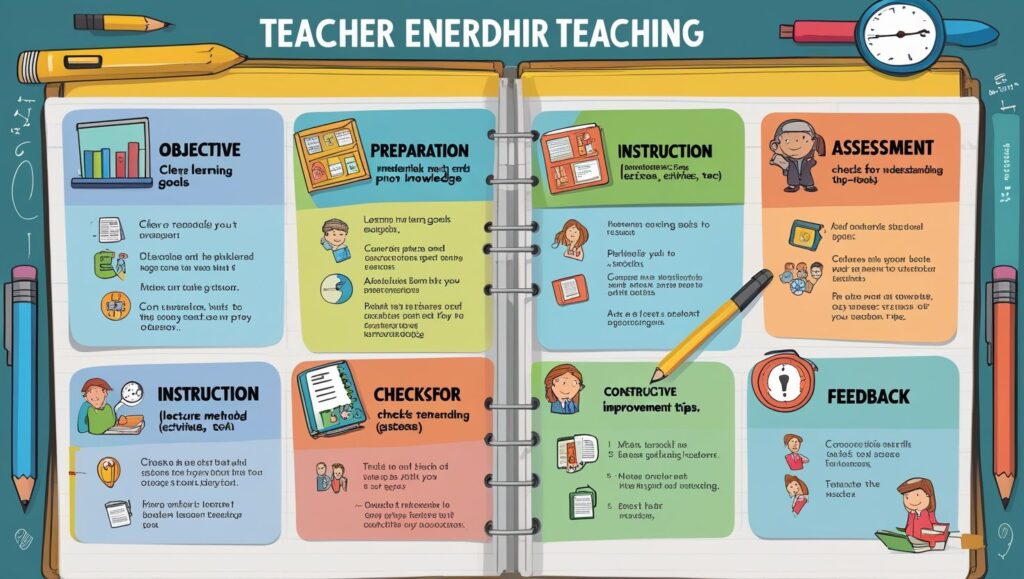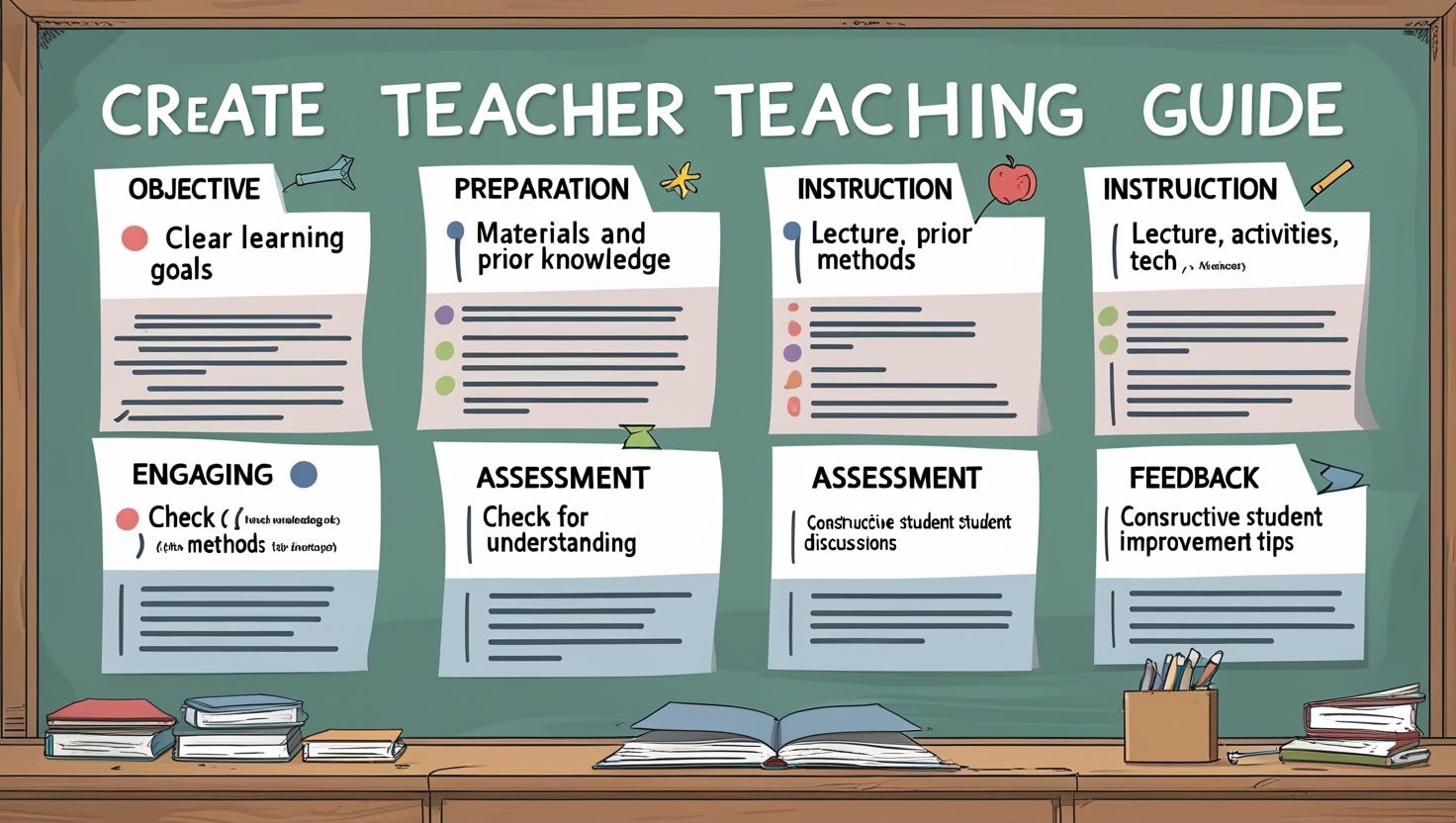Introduction
Teacher Teaching Guide in Education, A Teacher Teaching Guide is more than a collection of lesson plans—it is a strategic roadmap that links curriculum standards, evidence‑based pedagogy, and classroom realities into one coherent framework. By articulating clear learning outcomes, curating high‑impact instructional strategies, and weaving in assessment checkpoints, a well‑designed guide empowers teachers to move intentionally from “what to teach” toward “how learners will best grasp it.” It anticipates the diverse needs of students through universal‑design principles, provides practical routines for managing a positive classroom climate, and embeds cycles of reflection so practitioners continually refine their craft. In essence, a teaching guide functions as both compass and toolkit: it keeps instruction aligned with larger educational goals while equipping educators with the methods, resources, and confidence they need to translate those goals into daily, engaging learning experiences.
1. Clarifying Learning Outcomes and Curriculum Alignment
A teacher’s guide should begin by mapping every lesson to clear, measurable learning outcomes. Start with national or provincial curriculum standards, then translate those broad directives into student‑friendly “I can” statements—for example, “I can compare fractions with unlike denominators.” Backward‑design the unit: first envision the summative assessment that proves mastery, then plan formative checkpoints that ladder up to it. This alignment guards against the all‑too‑common trap of “activity‑rich but outcome‑poor” teaching. It also streamlines differentiation, because when targets are explicit, you can tier the same outcome at varying complexity levels (e.g., concrete manipulatives → pictorial models → abstract symbols).
Include a pacing guide that balances depth and coverage: cluster related standards, flag spiraling concepts for spaced retrieval, and build “flex days” to reteach. Finally, make cross‑curricular links visible—show how a science data table doubles as a math opportunity for mean, median, mode—to maximize instructional minutes and help students transfer knowledge across domains. Embedding these connections in the guide reinforces holistic learning and prevents siloed instruction.

2. Evidence‑Based Instructional Strategies
After outcomes, the guide should curate a toolkit of high‑yield strategies, annotated with when and why to use each. Start with explicit instruction for new content: short teacher modeling, think‑alouds that reveal metacognitive moves, and guided practice with fading scaffolds. Layer in retrieval practices—low‑stakes quizzes, flash‑card warm‑ups, exit tickets—to strengthen long‑term memory. Cooperative structures like think‑pair‑share and jigsaw cultivate dialogue and peer teaching, but specify protocols (time limits, accountable talk stems) to keep them purposeful.
Graphic organizers, dual‑coding sketches, and worked‑example pairs aid cognitive load management, especially for complex texts or multistep problems. Finally, integrate technology selectively: interactive simulations for otherwise abstract phenomena, adaptive quizzing platforms for immediate feedback, and collaborative documents for real‑time co‑authoring. Annotate each tool with research citations (e.g., Hattie’s effect sizes) so teachers see the evidence base and can prioritize the biggest “bang for buck” practices in crowded timetables.
3. Differentiation and Universal Design for Learning (UDL)
A robust teaching guide anticipates learner variability instead of reacting to it. Organize suggestions around UDL’s three pillars: multiple means of engagement (e.g., choice boards, culturally relevant examples), representation (audio, visuals, tactile manipulatives), and action & expression (oral presentations, infographics, coding projects). Provide tiered task cards: Level A for emerging proficiency with heavy scaffolds, Level B for on‑level practice, Level C for enrichment that extends depth and creativity.
Embed quick‑scan learner profiles—preferred modalities, language levels, IEP accommodations—so a substitute or co‑teacher can personalize on day one. Include sentence frames and word banks for English‑language learners; color‑coded organizers for dyslexic students; strategic seating charts that pair peer tutors with classmates needing support. Stress flexible grouping: regroup students by specific skill gaps rather than static “ability” labels, and schedule periodic student self‑selection to boost autonomy. Finally, coach teachers to pre‑plan extension menus so advanced students aren’t simply “helpers” but engage in authentic, challenging work.
4. Assessment for Learning and Feedback Loops
Treat assessment as a compass, not a scoreboard. The guide should illustrate the continuum: diagnostic pre‑assessments to surface prior knowledge; formative checks during learning; and summative tasks validating mastery. Supply banks of hinge questions—single, concept‑anchored items whose answers instantly reveal misunderstanding—alongside rubrics that convert abstract criteria into student‑friendly language and exemplars. Emphasize descriptive feedback over judgmental grades: comments that pinpoint what was done well, what needs improvement, and specific next steps. Encourage “teach‑back” conferences where students explain their errors, converting feedback into feed‑forward.
Incorporate self‑ and peer‑assessment routines: traffic‑light cards, single‑point rubrics, and reflection journals that reinforce metacognition. Embed data cycles: schedule weekly PLC minutes where teachers analyze common‑assessment results, identify reteach needs, and plan targeted interventions. Finally, outline ways to communicate progress to families—digital portfolios, narrative reports—turning parents into partners in the feedback loop.

5. Classroom Management and Positive Learning Environments
An effective guide frames management as cultivating community rather than imposing control. Begin with co‑constructed class norms that reflect shared values—respect, curiosity, perseverance—and rituals that make them visible: morning greetings, celebration walls for scholarly “first drafts,” restorative circles after conflicts. Detail proactive strategies: clear routines for transitions, visual schedules, and cue cards for common procedures. Incorporate Tier 1 PBIS elements—behavior expectations matrix, consistent positive reinforcement ratio (e.g., 4:1 praise‑to‑redirects), and menu of non‑verbal signals to pre‑empt disruptions.
Provide escalation pathways: calm‑down corners, reflection sheets, and scripted de‑escalation language (“I notice…, I need…, I wonder…”). Emphasize culturally responsive practices: pronounce names correctly, embed students’ funds of knowledge in examples, and audit classroom visuals for representation. Finally, advise on physical layout—U‑shapes for discussions, grouped pods for collaboration, quiet nooks for independent work—so the environment itself scaffolds engagement and autonomy.
6. Professional Reflection and Continuous Improvement
A teaching guide must also serve the teacher’s growth. Advocate for reflective cycles: plan → act → observe → reflect, using journals or video self‑analysis. Include checklists for lesson post‑mortems: Were outcomes met? Which students struggled and why? How effective were supports? Suggest peer observation protocols like the “instructional rounds” model—focus on a single problem of practice, collect low‑inference evidence, and debrief solutions. Provide templates for action research projects that test small instructional tweaks and measure impact. Encourage participation in professional learning communities, subject associations, and open‑education resource hubs to stay current. Outline pathways for mentoring: novice teachers paired with veterans, reciprocal coaching, and micro‑credentialing. Finally, promote wellbeing practices—time‑blocking for grading, mindfulness breaks, boundary‑setting around email—to sustain the energy necessary for continuous improvement.
7. Engaging Families and the Wider CommunityConclusion
An effective Teacher Teaching Guide transforms fragmented lessons into a cohesive, learner‑centered journey. By aligning curriculum targets with proven instructional strategies, timely assessments, and inclusive practices, it equips educators to teach with clarity and adapt with confidence. Beyond daily planning, the guide fosters reflective growth, strengthens classroom culture, and forges partnerships with families and the wider community.
In short, it serves as both a compass and a catalyst—ensuring that every lesson not only meets standards but also ignites curiosity, supports diverse learners, and advances the broader mission of equitable, high‑quality education. The final pillar connects classroom efforts with home and community resources. Recommend a welcome survey to learn about family languages, preferred contact modes, and talents they can share. Provide templates for bilingual newsletters, SMS micro‑updates, and five‑minute phone calls celebrating small wins. Coach teachers to host curriculum nights where parents experience mini‑lessons and grasp learning progressions; supply slide decks and hands‑on station ideas.

Outline volunteer and mentorship programs tapping local professionals for career talks or project feedback. Encourage community‑based learning: math walks in markets, history scavenger hunts in heritage sites, service projects with NGOs—turning neighborhoods into extended classrooms. Address barriers: offer child care during events, schedule sessions at varied times, and partner with community centers for Wi‑Fi access. Finally, integrate student voice—family interviews, heritage showcases—to honor cultural capital and strengthen the triad of teacher, learner, and caregiver, ensuring that learning does not end at the classroom door.
Conclusion
An effective Teacher Teaching Guide transforms fragmented lessons into a cohesive, learner‑centered journey. By aligning curriculum targets with proven instructional strategies, timely assessments, and inclusive practices, it equips educators to teach with clarity and adapt with confidence. Beyond daily planning, the guide fosters reflective growth, strengthens classroom culture, and forges partnerships with families and the wider community. In short, it serves as both a compass and a catalyst—ensuring that every lesson not only meets standards but also ignites curiosity, supports diverse learners, and advances the broader mission of equitable, high‑quality education.

It’s impressive that you are getting ideas from this post as well as from our discussion made here.